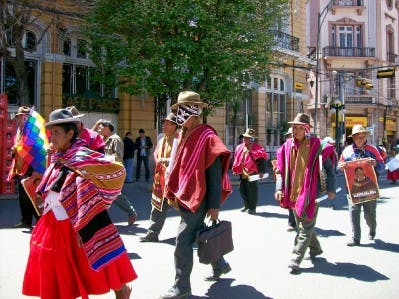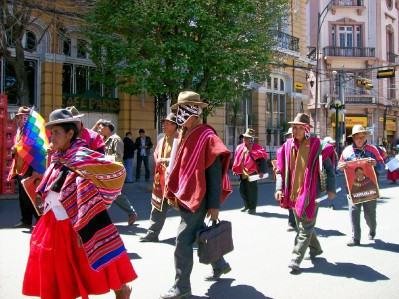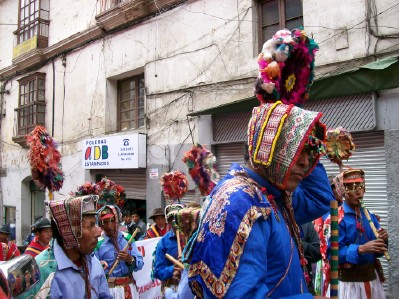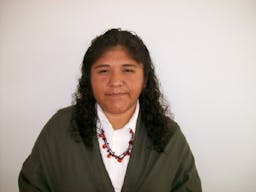A Look Through Indigenous Eyes
Jan 21, 2015
Story



“Wicked race”, were some of the words screamed publicly by a local authority from the opposition in Santa Cruz. Since pre Hispanic times there has always been a relationship between the indigenous peoples from highlands and lowlands for different reasons. So, up to now, there is a big population of indigenous peoples of highlands living and working in that region. But it seems that some local people in that city don´t like to see indigenous faces. They use the word “Indian” in a pejorative way to call anybody with an indigenous appearance. Last time I was in Santa Cruz, a man shouted at me “¡Indian, go out!”. I had done nothing that could disturb anybody. Just to be an indigenous woman was enough for that man to treat me that way. However, those authorities and some people, who call the indigenous peoples as a wicked race or use other scornful words, forget that Human Rights Universal Declaration in its article 13 says that “Any person has the right to freely walk and to select its residence within the territory of any State”. This is an example of how certain behaviors are alive. In the Bolivian case, I think it is important to look behind to see where these come from.
Bolivia was created as a Republic in 1825. The first two Presidents between 1825 and 1828 were foreigners: Bolivar and Sucre. However, with or without Republic, situation of indigenous peoples has been under extreme conditions in many occasions. During a long period, two themes have been present in different circumstances of the history: racism and discrimination. Racist actions against native inhabitants of these lands contrast with the respect to human rights established at world level. It is necessary to remark that part of the world population is the indigenous community not only in Bolivia but also in other countries and continents. So, it is important to find out, ¿What has changed since XVI century towards XX and XXI century for indigenous peoples?
During XVI century, Spaniadars kings and their fellows dominated to peoples. The first justification for the war against indians was made with the use of natural law. According to this law, losers should be under the power of winners. For them, Indians didn´t have culture and written laws.
Racism, since de arrival of Spaniadars, was generating the formation of ethnic social groups. Within the Spanish mentality it was possible to demonstrate their blood purity over Indians. From this, emerged stigmatic differences of human groups that were used to show the relationship between the superiority of a race over the inferiority of another.
Colonial society was generally divided in four racial groups, whites, criollos, mestizos and Indians. According to Spaniadars´ beliefs, conquerors had the first place in hierarchy. Indians as natives of these lands, according to their view were designated to be exploited, submitted to any kind of forced jobs and all the possible humiliations and abuses. This reality was expressed in 1798 by an author Martín Flores de Laja to the Governor as a reaction against the whites with the following words, “One only needs to be an Indian that anyone with white face pretends to receive complete obedience, pretends to be tolerated in all iniquity and use as an excuse to take off what is from another´s. Not only that, but also that, to be an Indian was enough to be punished with prison”.
Racism is present in all social and political structures inherited since colony in the belief of certain superiority. In this sense, Bolivian society until 1911 was formed by three racial groups, whites, mestizos and indigenous. The first ones, dominant in politics and economy during the Republic, never had a role to integrate the other members of the society. On the contrary, in many cases, they used their power in politics to abuse the others. Mestizos, the other group, with the time, slowly assimilated to the whites and became exploiters of the indigenous peoples; meanwhile indigenous population was discriminated and excluded from their social and political rights.
Bolivia has a rich cultural diversity with its 36 indigenous peoples. But, even before 1952 indigenous men or women were forbidden to enter the main square in La Paz. A quote from El Norte, a newspaper in August 1928, said that it contrasted with the modernity to see “… Indians sat on the stairs of Legislative Palace …”. Looked scornfully by invaders and later by those in power, step by step indigenous men and women had the possibility to get to the Bolivian Parliament. During the 1980´s decade, indigenous men became Deputies. I remember to Julio Tumiri, Constantino Lima and Luciano Tapia. Later, nearly at the end of 1990´s decade, the first indigenous aymara woman became Deputy, Remedios Loza. During an interview she said that, she was discriminated in her political party and in other circumstances. She referred that, although she had been able to win a place at the Bolivian Parliament, she had been considered incapable of getting other higher spaces in the government. Years later, other indigenous woman, Isabel Ortega, became Senator. Some time ago I could speak with her. She told me that she had started to work for indigenous peoples´ cause since she was very young. Ortega is now in her sixties but she remembers that, “I had to face many discriminatory attitudes”.
It arrived December 18, 2005, day of National Elections in Bolivia. That day, Evo Morales Ayma, was democratically elected as the 66th President by 53,74 % of the Bolivian population. The arrival to the Government for the first time in the history of Bolivia of an indigenous man has meant a huge step for indigenous communities here and in other places of our Mother Earth. From the nine millions of inhabitants in Bolivia, according to last census from 2001, 63% of the population is from indigenous origin. However, this majority was governed by a minority for ever.
Accustomed to have all the power, some members of the defeated parties during the last elections and referendums, have been taking racist actions against indigenous peoples. For example, May 25th 2008 in Sucre, a group of indigenous women and men were severely abused. Men were taken to the main square of Sucre. There, they were forced to sit on her knees. Groups of racists spat, hit, insulted to the indigenous men and forced them to shout words against the government. One of the most important symbols used by indigenous peoples of highlands named Wiphala was burnt by those groups. Angel Vallejos, an indigenous leader and Mayor of Mojocoya, a town in Chuquisaca, together with other indigenous leaders of the different communities were physically and psychologically assaulted. These violent groups neither respected to indigenous women. They also spat, hit and insulted them. Something similar happened in Santa Cruz, where, only to have an indigenous look was enough to be discriminated. There, and indigenous man, was persecuted by a group of men for about eight blocks to be hit and insulted. Except from a woman that tried to defend him, nobody else did anything to save that indigenous man from that racist attack.
Some, months later on September 11, 2008, a group of indigenous women and men in El Porvenir, Pando were stopped when they were going to have a meeting in Cobija, Pando. Men had to escape to a river to save their lives, but even though they were in the water, they were shot. More than ten indigenous men were killed by these racist groups. Later it was known that, some people who was supposed to have responsibility in that racist attack had escaped and one of the ex authorities of Pando is now in prison. According to the public report of the United Nations High Commissioner Office for Human Rights (OACNUDH) in Bolivia, the Pando´s Massacre was “a severe violation of human rights”. Last May 2009, survivors of this massacre went to the VIII Session of Permanent Forum for Indigenous Peoples to present their testimonies of these abuses.
Other way that some people use to try to ignore the existence of indigenous peoples in Bolivia is through a speech, which promotes that a majority is mestizo. One only has to take a brief look at the pre Hispanic history and history of Bolivia to see that there are indigenous peoples living since ancient times in all these lands. One finds indigenous peoples in all the cities from Bolivia: Santa Cruz, Beni, Pando, Tarija, Potosí, Oruro, Cochabamba, Chuquisaca and La Paz. As it had happened during XX century and before, it seems that the presence of an indigenous man or woman bothers to some people. However, indigenous peoples are ancestral owners of the lands and we: aymaras quechuas, guaranies, mayas, ashaninkas, mapuches, kunas, etc. are not only in what now is called Bolivia but also in other countries.
Last January 25th, a referendum took place in Bolivia which was approved by the majority of votes the new State Political Constitution. Its first article says that Bolivia is a Plurinational State, free, independent, democratic, intercultural and with autonomies. The second article recognizes the pre colonial existence of indigenous nations and peoples and recognizes the right to autonomy, self government, cultures, according to the Constitution and law. It is the first time since the foundation of Bolivia in 1825 that a Constitution includes all the population as established in its third article. This is an important document for all the citizens because it will allow from now on, taking part in political, social and economical spheres. For a long time, indigenous peoples were voters but not considered to be elected. At the Bolivian Parliament, now, there are people that belong to different indigenous peoples. This is a step, but it is also necessary that in other countries indigenous men and women could become parliamentarians, authorities at State levels or occupy other important places. As other step, last August 2nd in Camiri, Santa Cruz, in the presence of social organizations, members of indigenous peoples, President Evo Morales Ayma, officially announced the start of indigenous autonomies which is other historical fact for us.
Racist and discrimination actions have not ended. Indigenous peoples have always been guardians of natural resources and due to that, a risk is alive, that racist groups or exploiters reorganize with violent groups.
Indigenous peoples are human beings and part of this world too. In Bolivia the indigenous movement advances in the process of change, but also other countries as Ecuador. However, reconstitution of the global indigenous community is also very important for the changes that wait to our planet.
In Qullasuyu Marka, our leaders Tupak Katari and Bartolina Sisa inherited us their “qamasa”, “strength”. Tupak Katari before being killed by Spaniadars in 1781 said in aymara language “ Kutt´aniwa, ukatxa nayaxa waranqan waranqanipxawa” which means, “I will come back and I will be millions”. The words of our leaders became true, because although there were attempts to make us disappear or assimilate with different strategies, indigenous peoples will continue in our struggle to keep alive our cultures and the message of our ancestors.
This article is part of a writing assignment for Voices of Our Future, which is providing rigorous web 2.0 and new media training for 31 emerging women leaders. We are speaking out for social change from some of the most forgotten corners of the world. Meet Us.




